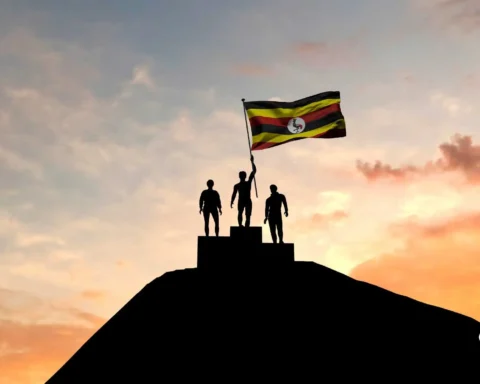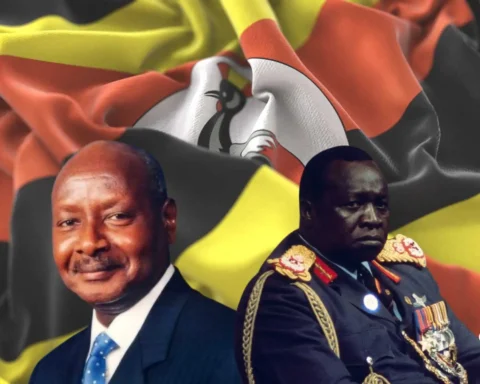Welcome, fellow enthusiasts of symbolism and national identity! Today, we embark on an exciting journey into the heart of Uganda, a country rich in culture, history, and natural beauty. We’re diving deep into a captivating emblem representing the essence of this East African nation – the National Emblem of Uganda, affectionately known as Uganda’s Coat of Arms.
This blog is your one-stop destination for everything you’ve ever wanted to know about this fascinating symbol. From its intricate design to the profound meaning it holds for the people of Uganda, we’re about to unravel the hidden stories and secrets behind this emblem. So, fasten your seatbelts because we’re about to embark on an informative and engaging exploration of Uganda’s national identity through the lens of its iconic Coat of Arms. Let’s dive right in!
Table of Contents
Importance of National Emblem
National emblems hold significant importance for any country, serving as powerful symbols of national identity, unity, and heritage. Here are some key reasons why national emblems are important:
- Symbol of National Identity: National emblems, whether flags, coats of arms with birds, or other symbols, represent a country’s unique identity. They often incorporate elements that reflect the nation’s history, culture, and values, making them a visual representation of what the country stands for.
- Unity and Pride: National emblems have the power to unite people from diverse backgrounds under a common banner. They foster a sense of belonging and pride among citizens, helping to forge a shared national identity. People can rally around their national emblem during important events and celebrations.
- Historical Significance: Many national emblems have historical significance. They may have been adopted at pivotal moments in a country’s history, such as independence or establishing a new government. As such, they remind a nation of its past struggles and achievements.
- Cultural Preservation: National emblems often incorporate elements of a country’s cultural heritage, including symbols, colours, and motifs holding importance to its various communities. This helps preserve and promote cultural traditions and diversity.
- International Recognition: National emblems are used on official documents, government buildings, passports, and international events. They are a means of representing a country on the global stage, making them instantly recognizable to people around the world.
- Education: National emblems are valuable educational tools. They are used in schools to teach students about their country’s history, geography, and values. They help instil a sense of national pride and identity in the younger generation.
- Diplomatic and International Relations: National emblems are used in diplomatic contexts, such as on flags at embassies and during state visits. They are also featured on currency and official documents, reinforcing a country’s sovereignty and status in the international community.
- Legal and Official Documents: National emblems are often present on official documents, including passports, visas, and currency. They serve as a mark of authenticity and authority for government-related paperwork.
- National Symbols: National emblems can become enduring symbols of a country’s character and values. They are often used in marketing and branding to represent the nation’s products, culture, and tourism industry.
- Inspiration and Aspiration: National emblems can inspire a sense of duty and aspiration among citizens. They represent the ideals and goals a nation strives to achieve, whether it’s freedom, justice, equality, or prosperity.
National emblems are much more than just symbols; they are essential components of a country’s identity and history. They play a crucial role in fostering unity, pride, and recognition nationally and internationally.
History of Uganda’s Coat of Arms
The history of Uganda’s Coat of Arms, also known as the national emblem, is intertwined with the country’s journey to independence and its evolving national identity. Here’s a brief history of Uganda’s Coat of Arms:
- Colonial Period: Prior to gaining independence, Uganda was a British protectorate known as the “Uganda Protectorate” from 1894 to 1962. Uganda did not have a distinct national emblem during this time, as it was under British colonial rule, and the British flag and symbols were used.
- Independence and Design: Uganda gained independence from British colonial rule on October 9, 1962. In preparation for independence, there was a competition to design a national emblem reflecting Uganda’s unique identity and aspirations as a newly independent nation. Grace Ibingira, a Ugandan attorney and politician, created the winning design.
- Symbolism: The Coat of Arms was carefully designed to encapsulate various aspects of Uganda’s history, culture, and values. It prominently features the Grey Crowned Crane, which is not only the national bird but also a symbol of vigilance and freedom. The shield and spears represent defence and unity, while the drum signifies the importance of music and cultural heritage. The wavy lines at the base represent Uganda’s abundant water resources.
- Adoption: Uganda’s Coat of Arms was officially adopted as a national emblem on the day of its independence, October 9, 1962. It symbolised the country’s newfound sovereignty and identity as a free nation.
- Continued Use: Over the years, the Coat of Arms has been proudly displayed on various official documents, government buildings, passports, and during national and international events. It serves as a constant reminder of Uganda’s history and values.
- Conservation: The Grey Crowned Crane featured in the emblem has also led to increased conservation efforts to protect this species in Uganda, as it holds cultural and ecological significance.
Uganda’s Coat of Arms
Uganda’s national emblem, often called the “Coat of Arms,” is a complex and symbolic representation of the nation’s heritage, values, and aspirations. Let’s break down the features of the National Coat of Arms in detail, explaining every aspect of it:
1. The Grey Crowned Crane: At the centre of Uganda’s Coat of Arms is the graceful Grey Crowned Crane (Balearica regulorum gibbericeps). This Uganda crane is found in the national coat and is one of Uganda’s most recognisable symbols and the official national bird. The crane stands on one leg and holds a spear and a cob of maise with its wings. This national bird represents several key aspects:
- Vigilance: The crane’s one-legged stance symbolises vigilance and readiness to defend Uganda’s interests and sovereignty.
- Freedom: It also represents freedom, reflecting Uganda’s journey to independence and its commitment to safeguarding its freedom.
2. The Shield and Spears: Surrounding the crane are two spears crossed behind a central shield is the badge of Uganda Protectorate. The shield and spears have several interpretations:
- Defence: The spears symbolise Uganda’s readiness to defend itself against threats or aggression.
- Unity: The crossed spears signify unity among the various ethnic and cultural groups that make up Uganda.
3. The Drum: Below the shield and spears is a traditional drum. This African drum holds cultural significance and represents the importance of music, dance, summoning of people, and cultural expression in Ugandan society.
4. Waves: At the base of the emblem are blue wavy lines, representing Uganda’s abundant water resources. Uganda is often called the “Pearl of Africa” due to its stunning Lake Victoria, the second largest freshwater lake in the world, and Lake Albert rivers and waterfalls.
5. The Crest: Above the central design is a crest composed of the Crested Crane (another name for the Grey Crowned Crane), a Ugandan Kob (antelope), and the River Nile. This part of the emblem further highlights Uganda’s natural beauty and wildlife.
6. The Motto: “For God and My Country,” is written on a ribbon below the emblem. This motto emphasises the importance of faith and patriotism in the lives of Ugandan people.
7. The Background Colors: The emblem typically features a white circular background with a green outer ring. The green ring symbolises Uganda’s lush vegetation, fertile land, and natural resources, while the white background represents purity and peace. The main cash crops or the major cash crops, coffee and cotton, are also included in the green mould, stating that this African country is an agricultural country.
National Flag of Uganda
Uganda’s national flag consists of six horizontal black, yellow, and red stripes arranged from top to bottom. The flag is a symbol of Uganda’s history and identity. Here’s a detailed description of Uganda’s national flag:
- Black Stripe (Top Stripe): The top stripe of the Ugandan flag is black. Black represents the African people and the continent of Africa as a whole. It is a symbol of the rich African heritage and identity of Uganda.
- Yellow Stripe (Second Stripe from the Top): A yellow stripe is below the black stripe. Yellow symbolises Uganda’s abundant sunshine year-round, earning it the nickname “The Pearl of Africa.” It represents the optimism and hope for the country’s future.
- Red Stripe (Third Stripe from the Top): The third stripe of the flag is red. Red symbolises the blood that Ugandans shed during their struggle for independence and the sacrifices made by the nation’s people. It is a symbol of the country’s courage and determination.
- Black Stripe (Fourth Stripe from the Top): Another black stripe follows the red stripe. This repetition of black signifies the African identity and heritage, reinforcing Uganda’s connection to the continent.
- Yellow Stripe (Fifth Stripe from the Top): Below the second black stripe is another yellow stripe, reiterating the representation of Uganda’s sunshine and hope.
- Red Stripe (Bottom Stripe): The bottom stripe is red, mirroring the third stripe’s significance of sacrifice and bravery.
The flag of Uganda was officially adopted on October 9, 1962, following the country’s independence from British colonial rule. It was designed to reflect Uganda’s cultural and historical values and its aspirations for a bright future.
National Anthem of Uganda
The national anthem of Uganda is titled “Oh Uganda, Land of Beauty.” It was officially adopted as the national anthem upon Uganda’s independence from British colonial rule on October 9, 1962. The anthem was composed by George Wilberforce Kakoma, and Professor W.W. Sekabembe wrote the lyrics.
Here are the lyrics to Uganda’s national anthem:
Oh, Uganda! May God uphold thee, We lay our future in thy hand; United, free, for liberty Together we’ll always stand.
Oh, Uganda! The land of freedom, Our love and labor we give; And with neighbors all, at our country’s call In peace and friendship, we’ll live.
Oh, Uganda! The land that feeds us, By sun and fertile soil, grown; For our own dear land, we’ll always stand: The Pearl of Africa’s Crown.
Conclusion
Uganda’s national emblem, the Coat of Arms, is a visually rich and meaningful representation of the nation. Its various elements convey themes of vigilance, freedom, unity, cultural heritage, natural beauty, and the importance of faith and patriotism. These aspects combine to create a symbol that embodies Uganda’s identity, history, and values. It serves as a visual and emotional anchor for all Ugandans, a source of pride and inspiration for future generations.
FAQs
What is the national flower of Uganda?
The national flower of Uganda is the “Lily.” It is officially known as the “Lily species Lilium Uganda” and represents purity and beauty.
Which is the biggest animal in Uganda?
The largest animal in Uganda is the African Elephant (Loxodonta africana), known for its impressive size and strength. It is often found in the country’s national parks and wildlife reserves.
Who designed the National Flag of Uganda?
The national flag of Uganda was designed by Grace Ibingira, an attorney and politician, in 1962.
Which is the next prominent bird other than the Crested Crane in Uganda?
The Marabou Stork (Leptoptilos crumenifer), often called the “Undertaker Bird,” is another prominent bird species in Uganda, known for its large size and distinctive appearance. It is often seen near water bodies, towns, and cities, scavenging for food.









